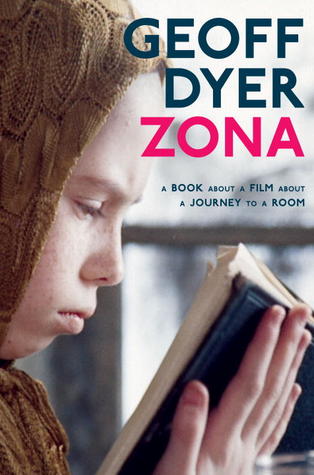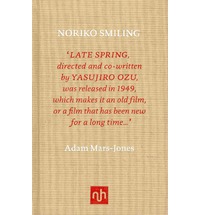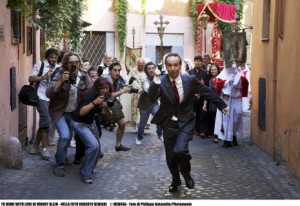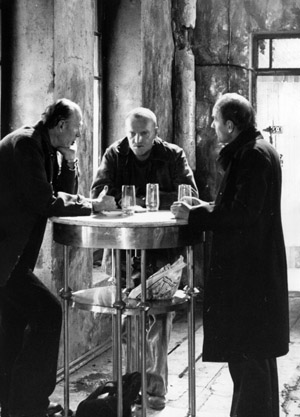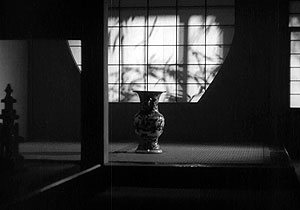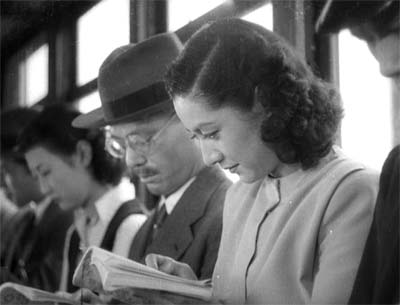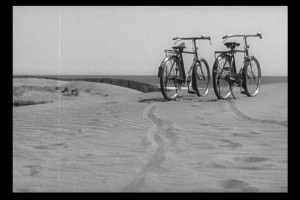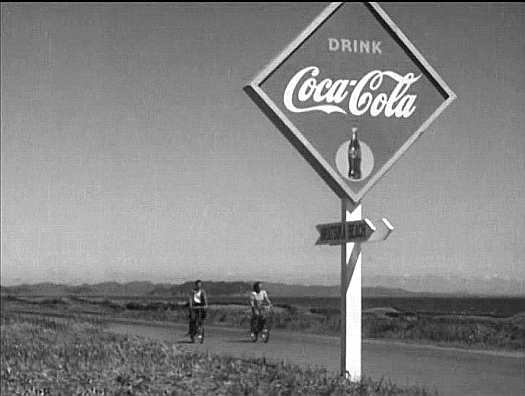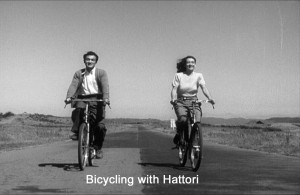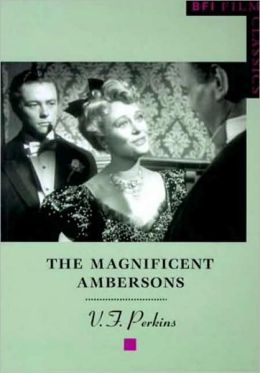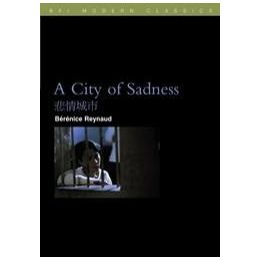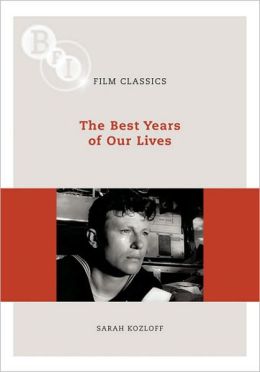A slightly edited version of this article entitled “Devotional Reading” appeared in the November-December 2012 issue of Film Comment. For whatever it’s worth, I find Geoff Dyer’s taped interview about Stalker on Criterion’s Blu-Ray more perceptive than anything in this book. I guess he’s had more time to think about it by now. — J.R.
There are at least two intriguing recent trends reflected in the publications of Geoff Dyer’s Zona: A Book about a Film about a Journey to a Room (New York: Pantheon, 2012) and Adam Mars-Jones’s Noriko Smiling (London: Notting Hill Editions, 2011) — book-length studies of masterpieces (Stalker and Late Spring, respectively) and film criticism by amateurs (both of them prestigious literary Brits). A couple of much older attitudes underlying both is a view of cinema as literature by another means and, conversely, a view of film analysis as a literary and linear pursuit.
It’s obvious that what links these two trends historically is the phenomenon of home viewing, which has made every viewer a potential “expert” for the first time. Prior to VCRs and DVD and Blu-Ray players, the only tools available for studying films at length were 16 mm projectors and moviolas, most often belonging only to “professionals” of one kind or another. But if we recall that amateur also means devotee, these books demonstrate how acts of devoted attention are more available now to everyone.
I hasten to add that my own definition of professionalism is existential, having nothing to do with whether one gets paid or handed a degree. Mars-Jones reviewed films for the Independent between 1986 and 1997, so calling him an amateur must sound impertinent. But he admits in his second sentence that he saw Late Spring for the first time in 2010, and, “I’d seen a couple of other Ozu films before it, perhaps a dozen Kurosawas, some in cinemas on first release, and a small handful of Mizoguchis.” Then he writes, “I can hardly be accused of being an expert on Japanese film,” and part of what I like about both Noriko Smiling and Zona is tied to periodic honest admissions of this kind, in refreshing contrast to the more common tendency to write with flourishes of bogus authoritativeness. (A prime recent example of the latter would be high-profile reviewers pretending to know something about Woody Allen’s swipes from Fellini in To Rome with Love when they can’t even identify the substantial chunks from The White Sheik. But generally speaking, fake confidence of this kind is quite common in British journalism, making the candor of Dyer and Mars-Jones even more exceptional.)
Dyer specializes in brandishing his own lack of expertise in whatever he chooses to write about — most memorably in But Beautiful (1996), one of the best books about jazz ever written — and with both writers I think it can be argued that their amateur status, however problematical it can get for readers who know more about their subjects than they do, is central to the spirit of adventure that infuses both their books. (I should confess at the outset that I’m only starting to get acquainted with Mars-Jones’ work while I’ve been reading Dyer with pleasure for years — even though I should add that Noriko Smiling is for me by far the more successful and useful of the two books, at least as criticism.) This rebelliousness may help to account for why each writer has taken on a film that much of the Anglo-American mainstream would call arty and tedious, leading in each case to a passionate defense — albeit in Dyer’s case one that periodically and dialectically lapses into curt, irreverent one-liners. Sometimes Dyer is utterly serious and in almost abject awe about Stalker and sometimes he wants to make rude rejoinders about how slow it is, and this unseemly yet provocative seesawing often corresponds to his “professional” and “amateur” impulses and the different sorts of readers addressed by each of them.)
The down side of this free-wheeling is an embrace of critical casualness that borders on complacency, trafficking in commonplaces that can make sense only to nonspecialists (such as the notion that David Thomson, a fearless amateur like them, is a formidable scholar-expert, to be trifled with at one’s peril — a position seemingly held without irony by both writers). The most irritating manifestation of this tendency may be Dyer’s “witty” insistence that if you remove color from Red Desert you’re “left with L’Avventura,” and “Since we’re speaking about truth and how it feels, I feel honor bound to admit that L’Avventura is the nearest I have ever come to pure cinematic agony”. I don’t mind anyone’s truth and honor, especially when they’re used as springboards for what Dyer actually likes about Stalker. But even so, I can’t help but protest the sort of essentialism that he knows will get instant applause from his most philistine readers. This is plainly and unabashedly an Anthony Lane moment (with many more of these to come), prompting me to counter that if you remove black and white from L’Avventura, maybe what you’re left with is Red Desert. Worse still, if you remove the wisecracks from Zona, what you’re often left with is neither criticism nor autobiography but some sort of equivocation.
This trouble seems tied to Dyer’s confusion about whether his autobiographical impulses and his critical smarts are supposed to be mutually interactive, mutually estranged, or some meaningful combination of the two — an issue that figured even more in his Out of Sheer Rage: Wrestling with D.H. Lawrence. I like it when Dyer confesses that he refused for a spell to revisit Stalker unless it was on projected film, until he decided to upgrade his home viewing with digital projection, at which point he “discovered” that Breathless, Belle de jour,and The Discreet Charm of the Bourgeoisie are all actually “pretty terrible” films. At least that’s what he asserts, but since he refuses to defend or even explain what the fuck he means by this, his critical smarts abruptly mutate into some sort of defiant solipsism — as with his dislike of L’avventura, which seems predicated largely on having initially seen it alone in Paris on a tiny screen.
Dyer can cross-reference Tarkovsky with Wordsworth, Rilke, and old LSD trips, and for me, at least, this all seems perfectly valid. It’s only when he attempts to link his favorite film with comparable cinematic touchstones for younger viewers and comes up with (I kid you not) Pulp Fiction and Gummo that I feel he’s out of his element — and perhaps not even speaking about art at all at this point, but fashion.
Maybe this perverse contrariness is part of his point. As he states explicitly at one point, he regards Stalker as a kind of existential test, much as the Zone’s Room functions within the film, and whether he flunks or passes this test is apt to shift from one page to the next. Insofar as the film was a test for me when I saw it for the first time, it was one I clearly flunked; indeed, I’ve rarely hated an art film more for its sheer mulish tenacity in deflating expectations, and it was only after I discovered that I couldn’t shake off its hypnotic persistence and its material and metaphysical drabness that I started to change my mind. One might even call it a battle of wills that I lost.
Insofar as Zona aspires to be mimetic criticism, it is undoubtedly testing me as well. But flunking in this case — whether it’s me flunking out with Zona or Dyer flunking out with me — has fewer ramifications. The seriousness of the critical study and the flippancy of the personal memoir neither mesh nor collide in any productive fashion; they simply (and willfully) coexist. Maybe I’m less sympathetic because I once attempted something along these lines myself, albeit with a movie having no artistic credentials (“On Moonlight Bay as Time Machine,” the lengthiest chapter of my 1980 memoir Moving Places), but I think Dyer’s challenge, insofar as he’s working with both a great film and an established audience, is markedly different from mine. And even if his frequent, cumbersome, meandering footnotes that make Zona so unreadable are “a structural solution, not a stylistic device” (as he told interviewer Ethan Nosowsky in The Believer), I simply can’t buy his theoretical justification: “With footnotes, the advantage is that as the distinction between discursive and narrative collapses in the course of the book, footnote-type material can creep into the main body of the text without a problem. Again, this is consistent with the film in that a literal journey gradually acquires more metaphysical-religious connotations.” Which slides around the inescapable fact that Stalker employs nothing remotely like a footnote.
***
Book-length film studies by amateurs can be traced back to Salmon Rushdie’s The Wizard of Oz, the volume that launched the BFI Film Classics twenty years ago — possibly the most bountiful book series in the history of film criticism in any language, easily surpassing the earlier French Seghers volumes devoted to directors, and one that might be said to sum up some of the gains film criticism can boast over the same period, when DVD extras, building on some of the precedents established on laserdiscs, started to become institutionalized. (As a way of pointing towards the sort of characteristic gains I have in mind, I’ve added a sidebar of five especially outstanding BFI titles, although many others could be cited.) Macmillan’s web site of BFI Classics volumes currently lists 86 titles — which doesn’t even include all of the series’ early entries, or the 48 + additional titles in the BFI Modern Classics — and the fact that these books keep appearing can be regarded as some sort of tribute to their staying power.
Prior to this, there were of course many other book-length studies of individual films, especially in academic publishing (e.g., Alfred Guzzetti on 2 or 3 Things I Know About Her, Kristin Thompson on Ivan the Terrible) and several book-length examples of“textual analysis” (a curious label for studies that were arguably more about psychoanalytical theories than about texts), such as Stephen Heath writing about Touch of Evil, and, in French, many of Raymond Bellour’s extended analyses of Hitchcock features. Otherwise, the series that comes closest to equating book and film may be the hardcover French packages recently released by Wild Side Video, combining Golden Age Hollywood features (e.g., He Ran All the Way, Wind Across the Everglades, The Story of G.I. Joe, Devil’s Doorway) with profusely illustrated 80-page critical/historical studies about them.
Apart from the common trait of being largely addressed to non-specialists, the differences between the BFI volumes and the recent books by Dyer and Mars-Jones remain palpable, suggesting a quite different niche market growing out of Rushdie’s musings about The Wizard of Oz. The BFI Classics are designed as handy, unfussy guidebooks, not entirely dissimilar to such venerable if less prestigious college outlines as Monarch Notes (the model of Indiana University Press’s Filmguide Series, which boasted about a dozen titles during the 1970s), whereas the curse and blessing of the Mars-Jones and Dyer texts is that they could never serve the same function, even if they strive to traverse much of the same ground in terms of their research. They’re simply too idiosyncratic and personal, too argumentative and speculative in their wayward drifts to serve as reference tools, even though they polemically challenge many of the more standard texts in terms of facts as well as interpretations.
The Dyer and Mars-Jones books share with earlier book-length studies a desire to suggest a certain completeness, yet they’re much less systematic in their formats and methodologies, which is part of the source of their freshness. Dyer has long been known for his digressions, and Mars-Jones, based at least on this volume, seems to rely periodically on epigrammatic conceits that sometimes amount to leaps of faith. Here are two particular favorites: “Hollywood cinema, like the World Series in baseball, lays claim to the planet without particularly noticing it.” “Films like Out of the Past or 2001 or Black Narcissus continue to make an impact even on television, shrunken in size and shot through with advertising jingles and alien flashing images, forced to defer to lesser technologies, to the doorbell, the kettle and the phone, humiliated in a domestic interior like kings sold into slavery.” And, even more to the point: “Western critics have gradually woken up to the fact that Ozu breaks as many rules as he keeps, and that he makes up plenty of his own. Being Japanese is not a state with a single dimension.”
Mars-Jones has a bee in his bonnet about other Ozu critics such as Donald Richie and Paul Schrader using Zen as a sort of all-purpose escape clause, privileging the climactic shots of a vase — which weren’t even mentioned in the original script — to account for the frissons between an aging professor (Chishû Ryû) and his still-unmarried daughter Noriko (Satsuko Hara) while avoiding pertinent issues about Japan’s recent defeat in the war and subsequent American censorship. (“The vase shot doesn’t dominate the film, but it seems to dominate discussions of it, looking over the skyline of its aesthetics.”) It’s emblematic of Mars-Jones’ modesty that his seemingly far-fetched theory about Noriko — that an enigmatic dialogue exchange about her “forced labor in the war” and an even more inexplicable reference to “her day off” during that period might allude to a sexual trauma that would help to explain her reluctance to get married — is never proffered as anything more than a stab in the dark, even though this is also made to serve as a meaningful climax to his investigation, like the final scene in a well-crafted novella.
He wants to explore and even deepen the film’s mysteries, not dispel them, but he doesn’t like mystification, either, and he suspects that some of those who feel otherwise may be motivated by something other than mysticism; “If we choose to take the Noriko smile at face value, it’s because we choose to think that the Japanese actually didn’t mind being fire-bombed and irradiated, that they kept the old Zen calm going when they saw the Sumida river, weeks after an air raid on Tokyo, choked with charred and bloated corpses. We have a strong vested interest in their serenity.”
Given the power of this insight, I find it easier to forgive the author not knowing who Shigehiko Hasumi (probably Japan’s greatest film critic) is, and not even suspecting that Hasumi’s (definitive) book about Ozu, whose final chapter is available in English in David Desser’s Tokyo Story collection, also refutes and deconstructs the Japanese-essentialist and Zen interpretations of Ozu, but in much more detail and with far greater conviction. There’s also an occasional lapse into a boiler-plate observation that happens to be wrong: “[By] the time of Late Spring, [Ozu] had more or less dispensed with camera movements.” But as Richard Peña points out in his audio commentary, when Norikio and Hattori go bicycling, the camera remains in motion almost throughout; only the last two shots in this sequence are filmed by a motionless camera. Amateurs writing for other amateurs, however insightful, are bound to stumble over such glitches; it comes with the territory.
***
Sidebar: Five Favorite BFI Classic Volumes(listed chronologically)
There are many plausible contenders for outstanding picks among the well over 125 titles to date in this series. I’ve excluded Frieda Grafe’s The Ghost and Mrs. Muir (1995), fascinating as it is, only because it doesn’t adequately represent the range of this late, great German critic, so that listing it here would be almost as misleading as attempting to introduce English readers to the richness of Serge Daney via Postcards from the Cinema rather than sergedaney.blogspot.com. Similarly, Yuri Tsivian’s excellent Ivan the Terrible (2002) pales beside the same author’s audiovisual essay on the Criterion DVD (which could also be said of Joan Neuberger’s short 2003 volume on the same film in I.B. Taurus’ excellent KINOfiles Film Companions).
- Lolita (Richard Corliss, 1994). Having contributed a couple of titles myself to the BFI Classics, Greed (1992) and Dead Man (2000), both literary in much of their orientation, I can appreciate the care and ingenuity brought by Film Comment’s former editor to Stanley Kubrick’s disputed 1961 film adaptation of Vladimir Nabokov’s masterpiece. Corliss even takes the calculated risk of basing his book’s structure on that of Nabokov’s Pale Fire — a 99-line poem in rhyming couplets followed by a lengthy (in this case, 76-page) commentary that manages to be both witty and judicious.
2.WR — Mysteries of the Organism (Raymond Durgnat, 1999).Dušan Makavejev’s greatest film (1971) — a far better example of “60s” radicalism than any of the efforts of Godard or Rocha that were being proffered as leftist models at the time — becomes an almost perfect vehicle for the particular strengths of England’s greatest film critic: not just an appreciation but an intricate dialogue with and around the object in question. As Durgnat avows in his Introduction, “I haven’t shared its Yugoslav experience, its regional ‘roots’, or its quasi-Marxist point of view. Mine is an outsider’s point of view — as so much art appreciation is, for we often value art as honest witness by other minds to experiences we can’t have had.”
3. The Magnificent Ambersons (V.F. Perkins, 1999). As James Naremore has noted, the only disappointing thing about this masterful, elegant, and insightful close analysis is that it isn’t longer. Yet it seems appropriate that such a flaw coincides precisely with what disappoints us about the surviving remnants of Welles’ achievement.
4. A City of Sadness (Bérénice Reynaud, 2002). There are few great films that benefit more from historical contextualizing than Hou Hsiao-hsien’s 1989 masterwork — the first Taiwanese film shot in direct sound, introducing the West to Hou’s work when it won the Golden Lion in Venice — and Reynaud’s placements, backed by detailed research and much critical discernment, are irreplaceable.
5. The Best Years of Our Lives(Sarah Kozloff, 2011). “Once there was a time,”Kozloff writes, “when a Hollywood movie could draw the whole country to the theatres and speak to their hearts.” This doesn’t make her blind to the fact that Harold Russell, the real-life veteran with hooks for arms who won one of the film’s seven Oscars, was paid only $6,000 while three of the other leads received $100,000 each and producer-director William Wyler earned $180,000 plus 20 per cent of the net profits. For far too long, this important film has either been celebrated uncritically or lambasted with truculent backlash (sometimes even by the same critics, as with Manny Farber), and Kozloff may be the first to come close to a balanced understanding. (See my web site for further comments.)
— J.R.

